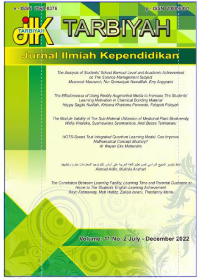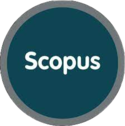The Effectiveness of Using Reality Augmented Media to Increase The Students’ Learning Motivation in Chemical Bonding Material
DOI:
https://doi.org/10.18592/tarbiyah.v11i2.7127Abstract
The purpose of this study was to determine the effectiveness of using Augmented Reality media to increase student learning motivation. This type of research is a quantitative quasi-experimental design with Pretest-Posttest Non-Equivalent Control Group Design. The sample in this study were 42 students in class X-Natural Science and X-Social Science. The research instrument used was a motivational questionnaire with 4 indicators, namely Attention, Relevance, Confidence, Satisfaction (ARCS). Data collection techniques were carried out by giving motivational questionnaires to students before and after learning. The data that has been obtained, then analyzed using the completeness formula of student achievement to determine the level of effectiveness of Augmented Reality media on student learning motivation. The results of the effectiveness of the media in the experimental class and the control class obtained the final motivational completeness percentages of 100% and 86%, respectively. Based on the results of the effectiveness of the media, it can be concluded that the use of Augmented Reality media is stated to be very effective for increasing student motivation in chemical bonding material.References
Baharuddin, H. (2007). Psikologi Pendidikan Refleksi Teoritis Terhadap Fenomena. Yogyakarta: Ar-Ruzz Media.
Hanik, A. N. (2015). Faktor-Faktor Penyebab Kesulitan Belajar Pengolahan Makanan Kontinental Siswa Kelas XI di Sekolah Menengah Kejuruan Negeri 3 Wonosari. Skripsi (Tidak Diterbitkan). Yogyakarta: Pendidikan Teknik Boga, Universitas Negeri Yogyakarta.
Iordache, D. D., Pribeanu, C., & Balog, A. (2012). Influence of specific AR capabilities on the learning effectiveness and efficiency. Studies in Informatics and Control, 21(3), 233–240.
https://doi.org/10.24846/v21i3y201201.
Irfan, I., Muhiddin, M., & Ristiana, E. (2019). Pengembangan Media Pembelajaran IPA Berbasis Powerpoint di Sekolah Dasar. Indonesian Journal of Primary Education, 3(2), 16–27.
https://doi.org/10.17059/ijpe.v3i2.21765
Keller, J. M. (1987). Development and use of the ARCS model of instructional design. Journal of Instructional Development, 10(3), 2–10.
https://doi.org/10.1007/BF02905780
Mugiarti, I. (2016). Pengembangan Media Pembelajaran Berbasis Multimedia Augmented Reality Pada Materi Ikatan Kimia. Skripsi (Tidak Diterbitkan). Jakarta: Pendidikan Kimia Universitas Negeri Jakarta.
Mustaqim, I. (2016). Pemanfaatan Augmented Reality sebagai media pembelajaran. Jurnal Pendidikan Teknologi Dan Kejuruan, 13(2), 174–183.
https://doi.org/10.23887/jptk-undiksha.v13i12.8525
Nastiti, F. N. (2020). Conection Understanding of Mathematic Concepts for the Learning Outcome Students Class VIII SMP N 1 Plosoklaten of the Circle Material. Jurnal Pendidikan Matematik, 4(1).
Purwanto, K. K., & Fatayah. (2019). Identifikasi Motivasi dan Kepuasan Belajar Siswa Dalam Pembelajaran Kimia Menggunakan Macromedia Flash. Prosiding Seminar Nasional Kimia dan Pengembangan (SNKP), 325–335. Retrieved from
http://kimia.fmipa.um.ac.id/wp-content/uploads/2020/06/29-Kriesna-Kharisma-Purwanto.pdf
Roedavan, R. (2014). Unity Tutorial Game Engine. Bandung: Penerbit Informatika.
Rusman. (2013). Belajar dan Pembelajaran Berbasis Komputer. Bandung: Alfabeta.
Sari, N., Sidauruk, S., Meiliawati, R., & Ristiyana, A. (2020). Kesulitan Siswa Kelas X MIA SMA Negeri di Kota Palangka Raya Tahun Ajaran 2018/2019 dalam Memahami Konsep Ikatan Kimia dengan Menggunakan Instrumen Two-Tier Multiple Choice. Gamaproionukleus, 1(2), 135–14.
https://doi.org/10.37304/jpmipa.v1i2.3686
Shatte, A., Holdsworth, J., & Lee, I. (2014). Hand-held mobile augmented reality for collaborative problem solving: A case study with sorting. 2014 47th Hawaii International Conference on System Sciences, 91–99.
https://doi.org/10.1109/HICSS.2014.20
Slameto. (2010). Belajar dan Faktor-faktor yang Mempengaruhinya. Cetakan ke 5. Jakarta: Rineka Cipta.
Smaldino, S. E., Lowther, D. L., dan Russel, J. D. (2012). Instructional Technology & Media for Learning. Jakarta: Prenada Media.
Sopiatin, P., & Sikumbang, R. (2010). Manajemen Belajar Berbasis Kepuasan Siswa. Bogor: Ghalia Indonesia.
Sulastri, S. (2017). Efektivitas Penggunaan Media Power Point Dalam Pembelajaran Pai Di Smp Tunas Dharma Way Galih Lampung Selatan Tahun Ajaran 2016/2017. Skripsi (Tidak Dipublikasikan). Lampung: Pendidikan Agama Islam IAIN Raden Intan Lampung.
http://repository.radenintan.ac.id/474/
Sumartono, S., & Huda, N. (2020). Manajemen Pendidikan di Indonesia Sebagai Implementasi Triple Helix Untuk Mempersiapkan Revolusi Industri 4.0. Jurnal Andi Djemma| Jurnal Pendidikan, 3(1), 74–79.
http://dx.doi.org/10.35914/jad.v3i1.340
Trisnawati. (2007). Implementasi Model ARCS (Attention, Relevance, Confidence, Satisfaction) dalam Pembelajaran PAI di SMA N 1 Brebes. Skripsi (Tidak Dipublikasikan). Semarang: Institut Agama Islam Negeri Walisongo.
http://eprints.walisongo.ac.id/id/eprint/11490/
Qumillaila, Q., Susanti, B. H., & Zulfiani, Z. (2017). Pengembangan augmented reality versi android sebagai media pembelajaran sistem ekskresi manusia. Cakrawala Pendidikan, 1, 57–69.
https://dx.doi.org/10.21831/cp.v36i1.9786
Yuen, S. C.-Y., Yaoyuneyong, G., & Johnson, E. (2011). Augmented reality: An overview and five directions for AR in education. Journal of Educational Technology Development and Exchange (JETDE), 4(1), 11.
https://doi.org/10.18785/jetde.0401
Zulfahmi, M., & Wibawa, S. C. (2020). Potensi Pemanfaatan Augmented Reality Sebagai Media Pembelajaran Terhadap Motivasi Belajar dan Respon Siswa. IT-Edu: Jurnal Information Technology and Education, 5(01), 334–343. Retrieved from https://ejournal.unesa.ac.id/index.php/it-edu/article/view/37491
Downloads
Published
How to Cite
Issue
Section
License
Authors retain copyright and grant the journal right of first publication with the work simultaneously licensed under a Creative Commons Attribution 4.0 International License that allows others to share the work with an acknowledgment of the work's authorship and initial publication in this journal.




